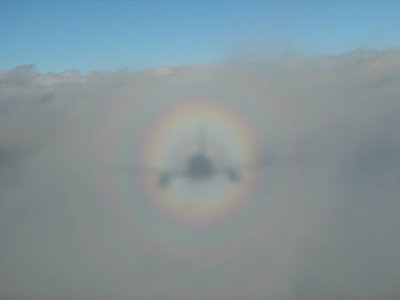Aerosol in Contrails?
Let me say unequivocally that there is no such program! Contrails are a natural phenomenon that occur when air at the right temperature and moisture content is passed through a jet engine. The advent of high-bypass turbojets (what you see on virtually all airliners these days) makes them even bigger. Within the contrails are signs they were produced by a large machine. This guy believes there are "cores" in the contrails. Those are caused by the engines themselves. High-bypass turbofans have two stages...the large fan stage that provides the vast majority of the thrust, and the smaller, but much hotter, core stage that provides the power to spin the fan stage. Both turn on the same axis with the N2 stage being interior to the N1 stage. With the right atmospheric conditions, the N2 stage (the smaller one) can create these secondary trails within the primary. There can also be a pattern of disruption from the wake turbulence from the wingtips. How they behave after creation has to do mostly with upper wind action. Every one of the pictures this guy shows can be explained. One thing's for sure...they really are neat pictures! But his conclusions are that of someone needing to wear an aluminum hat to protect himself from the aliens!
The specifics of any particular contrail has to do with the condition of the atmosphere in which the plane is flying. Thus this guy's "control photographs" are nothing more than a plane in different atmospheric conditions. I do know from time spent in NM that the skies there are often fabulously blue. There are also a multitude of jet airways that overlay the state. As a result, there are many days when the contrails are numerous and happen to stay around a while. There are other days when I fly when there are no contrails present. It's up to the atmosphere. Period. The altitudes at which you can expect contrails can actually be predicted. The military does this because a fighter certainly doesn't want a large white trail pointing the enemy to his plane! When in enemy territory, they will avoid the contrail altitudes in order to avoid easy detection.
And on top of that...we as pilots know our planes inside and out. This is necessary in order to deal with any malfunctions that occur. If there were actually something on our planes that would distribute this material into the air, we would know about it so we could deal with it in the event it malfunctioned. That would mean that there are tens of thousands of pilots who are all keeping their mouths shut. Oh...and then this device would have to be serviced, both in terms of regular maintenance and in terms of loading it with whatever this "chemical" is supposed to be. That would mean thousands upon thousands more people involved. It's getting really, really hard to keep a lid on such a "secret" program with that many people involved!
Sorry...enjoy the contrails in NM...but you have nothing to worry about but fluffy white water vapor!









